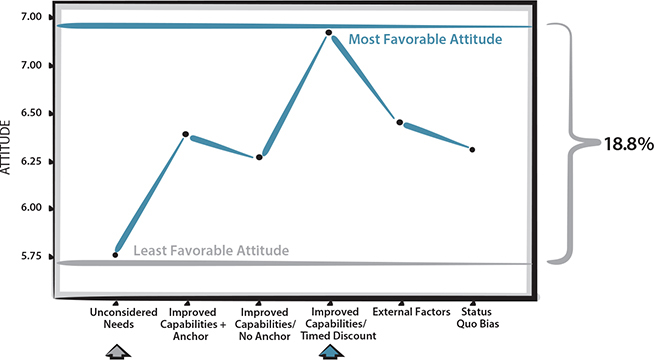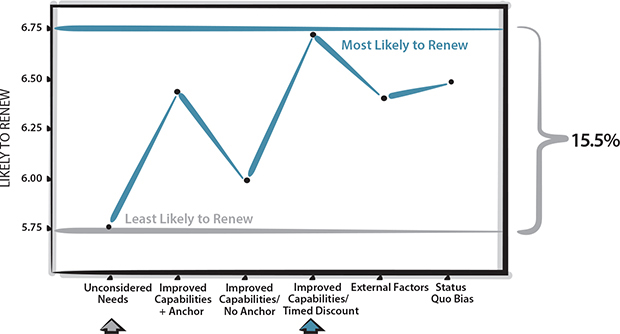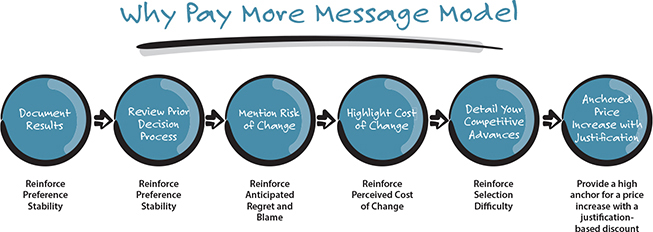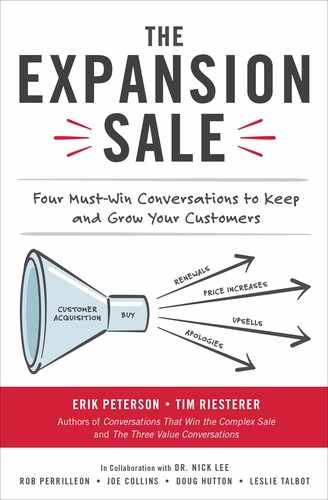 5
5 
Why Pay More
A Framework for Improving Your Price Increase Conversations
Since only 8 percent of companies are “very confident” in their price increase conversations and nearly four out of five companies want a more structured, rigorous approach, it’s past time to ask whether there’s an appetite for improvement. In partnership with Dr. Nick Lee of Warwick Business School, we set out to analyze the effectiveness of the six approaches detailed in Chapter 4, with an eye toward discovering which delivered the most favorable outcomes—that is, which was best for communicating a price increase while minimizing the risk of dissatisfaction and defection. This distinction is important, because we didn’t approach this study looking for a message that would lead a customer to exclaim, “Yes! Now that I understand it, I’m really glad you’re raising my price!”
The six approaches were inserted into the following scenario:
Participants were told to imagine they were small-business owners nearing the end of a two-year contract with a vendor they’d hired to promote their company’s health and wellness program to employees, a move designed to improve employee satisfaction and retention rates. It was time to either renew with the existing vendor—at a 4 percent price increase—or consider switching to a new vendor.
All the test conditions in this experiment included the same 4 percent price increase. In addition, they all opened the same way by documenting the same business results achieved during the first term of the contract (an element essential to a favorable renewal). From there, the test conditions varied based on the approach:
1. Unconsidered Needs (Why Change message model). This scenario assumed a price increase would be more palatable if the customers saw it as part of a significant change and update to their solution. The message introduced new research revealing an alternative approach to plan participation that would require additional services that cost 4 percent more. The message also assured the customers they would recover that price increase within a year, based on improved program performance. So they’d pay more, but they’d get necessary capabilities and a calculated payback on the additional costs.
2. Improved capabilities with a pricing anchor. This test condition described additional new capabilities and improvements that would be included with the renewal. It described how the new capabilities would increase performance and progress toward the customer’s top goals. It also explained that these new capabilities would ordinarily add 8 percent to the annual program cost; however, existing customers would have that increase halved to 4 percent for being loyal customers. The net price increase was the same 4 percent as the rest of the test conditions offered, but it was presented with a high “anchoring” increase and a loyal customer discount.
3. Improved capabilities without a pricing anchor. This test condition mirrored the one above, except without “anchoring” the higher price point. It simply presented the new capabilities and performance as a justification for a straight-up 4 percent price increase.
4. Improved capabilities with a time-sensitive discount. This test condition introduced the improved capabilities and described how they would improve performance, as detailed above, and acknowledged that the new capabilities would add 8 percent to the annual cost. But in this case, it offered a time-sensitive discount—a 50 percent reduction in the increase (for a net 4 percent increase) provided the customer renewed by the end of the month. Since many companies rely on this approach to spur customers to renew quickly, we were curious to see how well it would perform in a controlled test against other approaches.
5. External cost factors. This message cited external costs as the reason for the increase—specifically, regulations and mandated changes that added cost to the vendor supplier that necessitated an 8 percent cost increase. In a goodwill gesture, this approach used an anchor, explaining the vendor would absorb half the extra cost burden but must pass along the remaining 4 percent to the customer. This is a very real and common justification for a price increase, so we were interested in seeing how the “excuse” approach would fare against others.
6. Status Quo Bias reinforcement (Why Stay message model). This scenario framed the price increase in the winning Why Stay message approach. It assumed that reinforcing the Status Quo Bias, and reminding customers of the potential risks and costs associated with bringing in a new vendor, could also work in a price increase setting. In this message, we took a very conservative approach and communicated a straight 4 percent price increase with no anchoring.
THE RESULTS
Every test condition asked for the same 4 percent increase. And each condition opened by documenting the same business results achieved during the first contract term.
But this study showed clear winners and losers.
The biggest loser was the “Unconsidered Needs” approach modeled against the Why Change message. It finished dead last in every category:
• Participants who heard the price increase in the Why Change context had an 18.8 percent less favorable attitude toward the vendor compared with the winning approach (Figure 5.1).

Figure 5.1
• They were also 15.5 percent less likely to renew with their current vendor compared with the winning message (Figure 5.2).

Figure 5.2
• And they were 16.3 percent more likely to switch to a competitor offering discounted pricing (Figure 5.3).

Figure 5.3
Figures 5.1–5.3 Why Change messaging loses big in a renewal scenario—finishing dead last in favorable attitude toward vendor and likelihood to renew and finishing first in switching likelihood.
Why would this last condition perform so poorly? One would assume that if you’re offering new capabilities the customers don’t currently have, they’d see all sorts of new value . . . right?
If you recall the findings from the renewal study documented in the previous chapter, you will also recall that introducing an Unconsidered Need had a detrimental effect on the renewal message. According to our research partner, Dr. Nick Lee, introducing the Unconsidered Need would likely provoke customers to “think more carefully about what they want and how to get it.” By disrupting your customer’s status quo, you’re creating discomfort and prompting them to reassess their situation—including your status as their provider.
Meanwhile, the winning price increase message appears to embody two things: First, it reinforces the status quo while introducing competitive advances that align with the customer’s business goals. Second, it anchors high with the new price before giving the justified discount to secure the renewal.
The “external factors” condition is notable, because in the survey cited in the previous chapter this was the most commonly used strategy. While this strategy did reasonably well, it was outperformed in every category. When we ask our clients why they prefer this strategy, they say it shows the price increase is beyond their control and thus “not their fault.” This is an understandable instinct, and it might feel better to tell your customers you wish you didn’t have to do this. But put yourself in your customer’s position. They’re still getting a price increase. It might not be your fault, but it’s still their problem.
So what was the winning condition? Per the results above (Figures 5.1–5.3), the Why Stay message, coupled with the timed discount, performed the best.
THE WINNING WHY PAY MORE CONDITION
The research confirms that, much like a compelling customer retention message, an effective price increase message will document proven business results, reinforce Status Quo Bias, detail competitive advances that improve performance against original business needs and goals, and anchor a price increase but then offer a loyalty discount (Figure 5.4).

Figure 5.4 Use the Why Pay More message model to keep your customers buying, and paying more for, their existing solution.
Here’s the actual text of the winning approach:
1. Document results. You have made great progress on your goals over these last two years. You’ve seen health and wellness program participation grow from 20 percent to 50 percent. Your employee satisfaction scores are up, and you’ve said some employees have even taken the time to thank you for the changes you’ve made. In addition, your employee retention rates have started to improve, which you said was the ultimate goal of making these changes.
2. Review the prior decision process. When you signed up two years ago, you really did your homework and looked at a lot of options before getting your entire team to come to a consensus and choose our company. It was a long process that involved a lot of people, but you ultimately arrived at a big decision to bring this program on board.
3. Mention the risk of change. As you look at making a renewal decision, it’s important to realize that you are at a critical point in this journey and that it’s important to maintain momentum to achieve your ultimate participation and retention goals. Any change to the program at this point could create an unnecessary risk of losing the positive gains you’ve made.
4. Highlight the cost of change. Not to mention that bringing in another vendor would require you to invest both time in getting the vendor up to speed and money on implementation costs and other changes that you won’t have to spend if you continue working with us.
5. Detail competitive advances. Over the last two years we’ve been developing new capabilities to drive more satisfied participants, as well as give you confidence that your program is keeping pace with anything else available in the market today. As you consider your renewal with us, we wanted to let you know about two new services we think can have a tremendous impact on your goals. The first is a new weekly report that shows nonparticipants in the program how much benefit those who are participating are seeing in terms of their fitness and wellness, as well as how much they are saving, and benefiting in terms of healthcare, by being part of your plan versus the alternatives. This kind of communication on a monthly basis will provide a gentle nudge to help encourage them to get into the program for the great benefits.
Second, we’ve also added a new smartphone app with online tools, including automatic result tracking, and integration with popular fitness trackers. In tests, these touches have been shown to help your employees get more benefits from health and wellness programs, and feel like they’re making progress on their goals. The result has been shown to be higher employee plan satisfaction.
6. Anchor the price increase high and introduce “justified” discount. These new services and functionality will add approximately 8 percent to the annual cost of your plan. However, if you renew before the end of the month, we will reduce the price increase by 50 percent, making it just a 4 percent overall increase to get this level of service. You’re making great progress. Stick with our program for another two years, and I know you’ll get to your 80 percent participation goal and further increase your employee retention rates.
As you see, this model closely follows the first five steps of the Why Stay message framework. Note also how the bolded text in the “Detail competitive advances” step describes new capabilities as keeping pace with the market, rather than disrupting the status quo, and ties them directly to the customer’s original goal of increased participation. By framing competitive advances in this way, rather than as new and cutting edge, you’re able to demonstrate you’re staying current with the market without undercutting your own Incumbent Advantage.
Now you know how to keep your customers buying, and potentially paying more for, their existing solution: Reinforce Status Quo Bias and, whatever you do, don’t disrupt yourself.
But what happens when you do need to disrupt yourself? What happens when you need to move your customer off the solution . . . but not away from your company?
That hybrid message is what you’re going to learn about next.
* Robert B. Cialdini, Pre-Suasion: A Revolutionary Way to Influence and Persuade, 2016.
